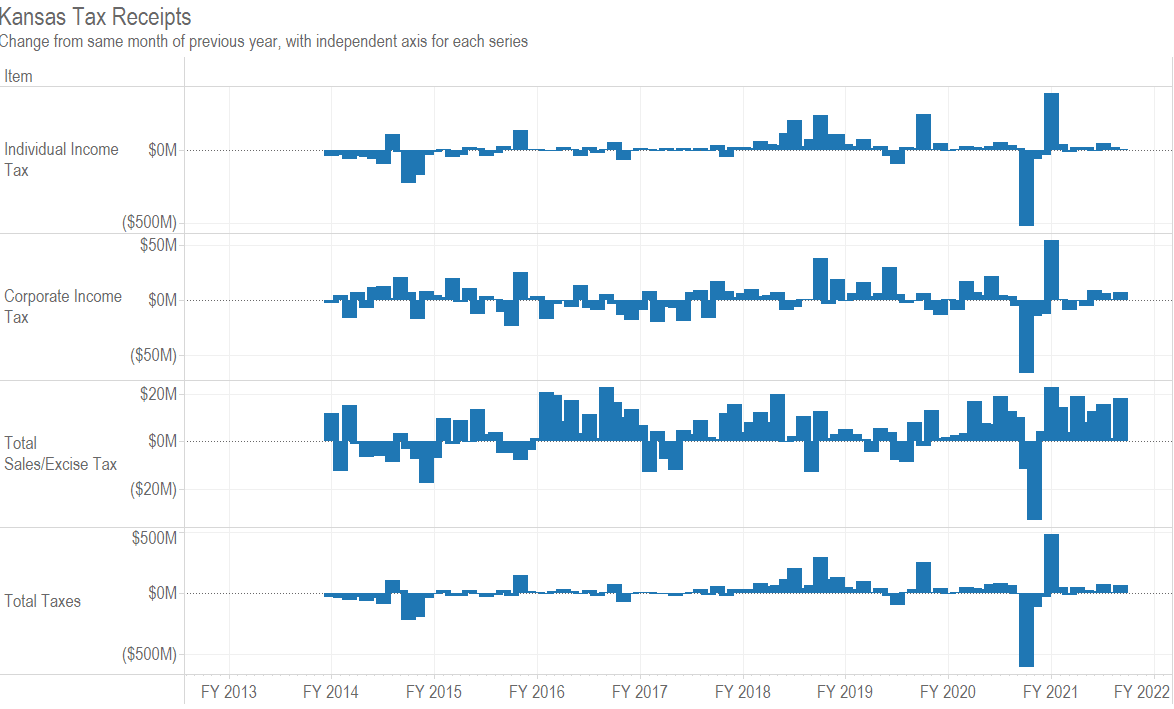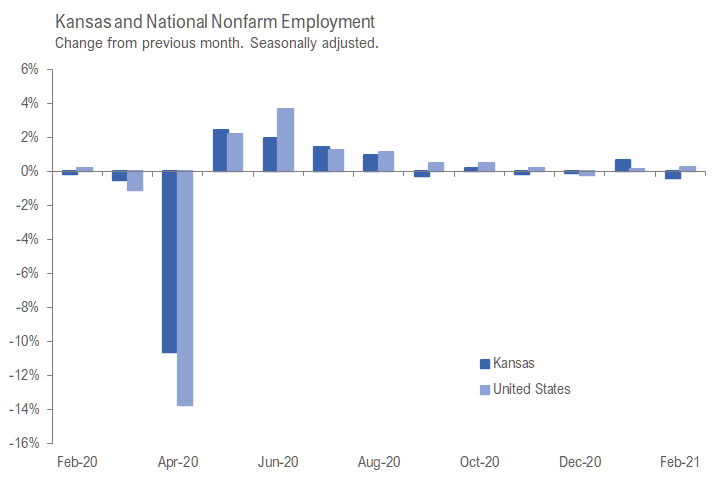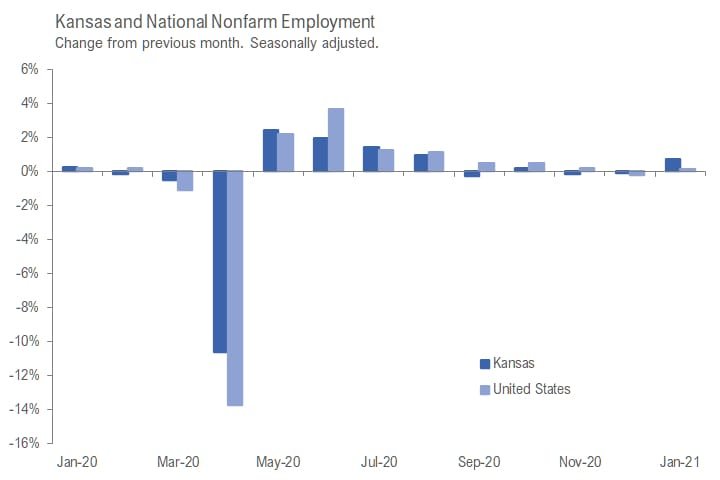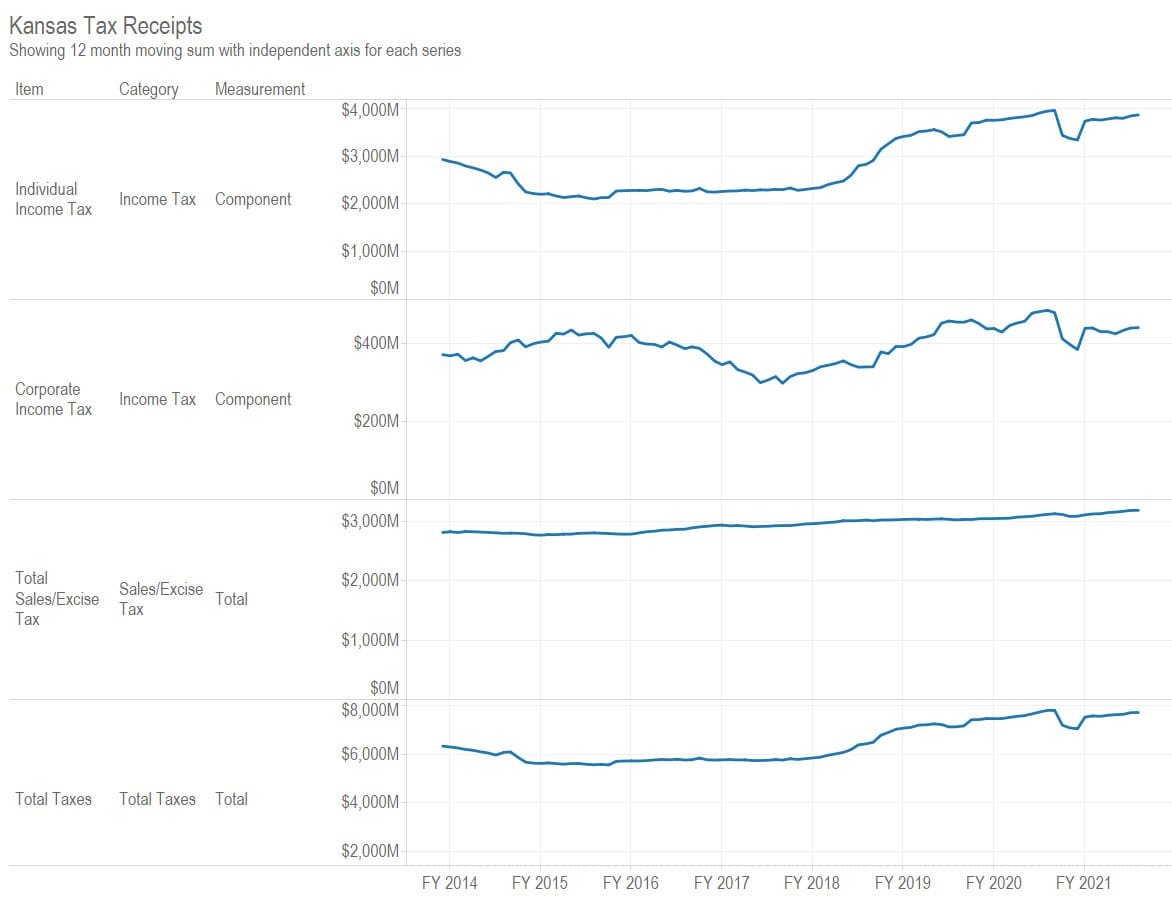In Kansas for April 2021, the labor force fell, the number of people working fell, and the unemployment rate fell, all compared to the previous month. (more…)
Category: Kansas state government

Kansas tax revenue, April 2021
For April 2021, Kansas tax revenue was 69.9 percent greater than April 2020. Over the ten months of the current fiscal year, revenue is 19.5 percent higher than at the same point of the previous year. There are caveats to consider. (more…)

Kansas jobs, March 2021
In Kansas for March 2021, the labor force grew, the number of people working rose, and the unemployment rate fell.
Data released yesterday from the Bureau of Labor Statistics, part of the United States Department of Labor, shows an improving employment picture in Kansas for March 2021.
(Click charts and tables for larger versions.)
Using seasonally adjusted data, from February 2021 to March 2021, nonfarm employment in Kansas rose by 12,800 jobs (0.9 percent). Over the year, the number of Kansas nonfarm jobs for March 2021 was lower by 48,900 (3.4 percent) over the same month last year. This is using seasonally adjusted data. The non-adjusted figure is 46,600 fewer jobs (3.3 percent).
Over the year (March 2020 to March 2021), the Kansas labor force rose by 14,718 people (1.0 percent) using seasonally adjusted data, with an increase of 2,139 (0.2 percent) over the last month. Non-seasonal data shows an increase of 19,566 (1.3 percent) in the labor force over the year.
Since July, the monthly jobs count has both risen and fallen, usually by small amounts. The increase for March is significantly larger than any change since then. There are now 102,200 more jobs in Kansas than in April 2020, which is the low point since the pandemic. There are 55,800 fewer jobs than in February 2020, just before the pandemic.
The number of unemployed persons fell from February 2021 to March 2021 by 669 (1.2 percent). The unemployment rate was 3.7 percent in March, up 0.5 from last March, and down 0.1 percentage points from last month.
Comparing Kansas to the nation: Using seasonal data, the number of Kansas nonfarm jobs is 3.44 percent lower than 12 months ago, while nationally, the same statistic is 4.46 percent lower. Non-seasonal data shows the number of Kansas nonfarm jobs is 3.29 percent lower than 12 months ago, while nationally, the same statistic is 4.37 percent lower.
Click charts and tables for larger versions.
In the following chart showing job changes from the previous month, we can see the larger increase in jobs for March compared to months since August.
In the following chart of job levels from the same month one year ago, the recent monthly figures show the recovery continuing in most months.
In the following chart of unemployment rates, we see that the rate in Kansas is lower than the national rate, both before and after the pandemic. The unemployment rate in Kansas is generally declining, but not in every month.
In the following chart of changes in the labor force for Kansas and the nation, the labor force has both grown and shrank since the pandemic.
For industry groups, the following charts show the number of employees in various industries in March 2020 and March 2021.
This chart uses the same data, but shows the percent change from March 2020. The Information category is lowest, proportionally, followed by the Mining and logging category. The Construction and Trade, Transportation, and Utilities industry groups have gained employees.
The report for this month from the Kansas Department of Labor is here. The report from BLS may be found here.

Kansas tax revenue, March 2021
For March 2021, Kansas tax revenue was 12.7 percent greater than March 2020. Over the nine months of the current fiscal year, revenue is 14.0 percent higher than at the same point of the previous year. (more…)

Kansas school spending
Kansas school district spending, updated through 2020 and adjusted for inflation.
What is the trend in Kansas school spending? This visualization presents several tables and illustrations of spending data. It is presented separately for each district, with a special district “State Totals – 999” being the sum of all districts. (more…)

Kansas jobs, February 2021
In Kansas for February 2021, the labor force shrank, the number of people working fell, and the unemployment rate fell.
Data released today from the Bureau of Labor Statistics, part of the United States Department of Labor, shows a deteriorating employment picture in Kansas for February 2021, even though the unemployment rate fell. (more…)

National Assessment of Educational Progress (NAEP) for Kansas
Looking at Kansas school test scores as compared to the nation. (more…)

Kansas jobs, January 2021
In Kansas for January 2021, the labor force shrank while the number of people working rose, resulting in a drop in the unemployment rate.
Data released this week from the Bureau of Labor Statistics, part of the United States Department of Labor, shows a mixed employment picture in Kansas for January 2021.
(Click charts and tables for larger versions.)
Using seasonally adjusted data, from December 2020 to January 2021, nonfarm employment in Kansas rose by 10,000 jobs (0.7 percent). Over the year, the number of Kansas nonfarm jobs for January 2021 was lower by 66,400 (4.6 percent) over the same month last year. This is using seasonally adjusted data. The non-adjusted figure is 68,000 fewer jobs (4.8 percent).
Over the year (January 2020 to January 2021), the Kansas labor force rose by 2,256 people (0.2 percent) using seasonally adjusted data, with a fall of 15,983 (1.1 percent) over the last month. Non-seasonal data shows a rise of 23,222 (1.6 percent) in the labor force over the year.
The Kansas economy had been adding jobs each month since May, but there was a decline in September. Since then, the monthly jobs count has both risen and fallen by small amounts, but the increase of 10,000 in January is significantly larger. There are now 93,900 more jobs in Kansas than in April 2020, the low point since the pandemic. There are 64,100 fewer jobs than in February 2020, just before the pandemic.
The number of unemployed persons fell from December 2020 to January 2021 by 19,635 (27.4 percent). The unemployment rate was 3.5 percent in January, up 0.4 percentage points from one year ago, and down 1.2 percentage points from last month.
Comparing Kansas to the nation: Using seasonal data, the number of Kansas nonfarm jobs is 4.64 percent lower than 12 months ago, while nationally, the same statistic is 6.28 percent lower. Non-seasonal data shows the number of Kansas nonfarm jobs is 4.81 percent lower than 12 months ago, while nationally, the same statistic is 6.07 percent lower.
Click charts and tables for larger versions.
In the following chart showing job changes from the previous month, the magnitude of the changes in April through August overwhelms the other months. Since then, changes have been smaller, and both rising and falling, although January saw a large positing upswing.
In the following chart of job levels from the same month one year ago, the recent monthly figures show the recovery slowing for both Kansas and the nation.
In the following chart of unemployment rates, we see that the rate in Kansas is lower than the national rate, both before and after the pandemic.
In the following chart of changes in the labor force for Kansas and the nation, the labor force has both grown and shrank since the pandemic.
For industry groups, the following charts show the number of employees in various industries in January 2020 and January 2021.
This chart uses the same data, but shows the percent change from January 2020. The Leisure and hospitality category is still the lowest, proportionally, followed by Mining and logging and Information. The only industry group to gain employees is Trade, Transportation, and Utilities.
The report for this month from the Kansas Department of Labor is here. The report from BLS may be found here.

Kansas tax revenue, February 2021
For February 2021, Kansas tax revenue was 1.7 percent greater than February 2020. Over the eight months of the current fiscal year, revenue is 14.2 percent higher than at the same point of the previous year.
Tax reports from the State of Kansas for February 2021 show tax revenues falling from the previous month, but higher than the same month the prior year, despite the effects of the response to the pandemic. The fall from January is characteristic of the seasonal pattern.
When reporting on Kansas tax collections, the comparison is usually made to the estimated collections. Those estimates were revised in April 2020 based on economic conditions affected by the response to the pandemic. To get a feel for the effects of the response to the pandemic, it is best to compare to the same month the prior year.
(The estimated revenue figures are still important because the state budget is based on them. If the actual revenue is much below the estimated revenue, there may not be enough income to pay expenses.)
For February 2021, individual income tax collections were $193.7 million, up by 13.0 percent from the prior February. Retail sales tax collections rose by 0.8 percent to $179.3 million. Total tax collections were $455.9 million, up 1.7 percent from the same month the prior year. A nearby table summarizes.

For fiscal year 2021, which started on July 1, 2020, total tax collections are up by 14.2 percent over the same period of the previous fiscal year. A large reason for this is the change in tax deadlines from April to July, shifting much revenue from fiscal year 2020 to fiscal year 2021. That hasn’t always been explained, as I show in In Kansas, explanations for tax collections may vary.
As can be seen in a nearby table, tax revenue for fiscal year 2021 is $673.9 million greater than at the same time in the previous fiscal year. Of this, $527.0 million, or 78.2 percent, is due to the increase in individual income tax revenue.

My report on tax revenue for April details some changes made by the estimating group.
My interactive visualization of Kansas tax revenue has been updated with October data. Click here to use it.
An example from the visualization illustrates the composition of Kansas tax revenue for the last year ending in November 2020. Individual income tax accounted for 50.5 percent of revenue, and retail sales tax 31.5 percent. Together, this is 82.0 percent. Add compensating use tax of 7.0 percent and corporate income tax of 5.6 percent, and that is nearly all — 94.6 percent — of Kansas tax revenue.
The governor’s press release for this data is at February Total Tax Collections Outperform Estimate by $19.8 million.






































